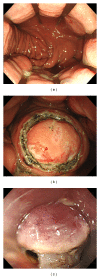Current innovations in endoscopic therapy for the management of colorectal cancer: from endoscopic submucosal dissection to endoscopic full-thickness resection
- PMID: 24877148
- PMCID: PMC4022075
- DOI: 10.1155/2014/925058
Current innovations in endoscopic therapy for the management of colorectal cancer: from endoscopic submucosal dissection to endoscopic full-thickness resection
Abstract
Endoscopic submucosal dissection (ESD) is accepted as a minimally invasive treatment for colorectal cancer. However, due to technical difficulties and an increased rate of complications, ESD is not widely used in the colorectum. In some cases, endoscopic treatment alone is insufficient for disease control, and laparoscopic surgery is required. The combination of laparoscopic surgery and endoscopic resection represents a new frontier in cancer treatment. Recent developments in advanced polypectomy and minimally invasive surgical techniques will enable surgeons and endoscopists to challenge current practice in colorectal cancer treatment. Endoscopic full-thickness resection (EFTR) of the colon offers the potential to decrease the postoperative morbidity and mortality associated with segmental colectomy while enhancing the diagnostic yield compared to current endoscopic techniques. However, closure is necessary after EFTR and natural transluminal endoscopic surgery (NOTES). Innovative methods and new devices for EFTR and suturing are being developed and may potentially change traditional paradigms to achieve minimally invasive surgery for colorectal cancer. The present paper aims to discuss the complementary role of ESD and the future development of EFTR. We focus on the possibility of achieving EFTR using the ESD method and closing devices.
Figures




Similar articles
-
Colorectal endoscopic submucosal dissection: Technical advantages compared to endoscopic mucosal resection and minimally invasive surgery.Dig Endosc. 2014 Jan;26 Suppl 1:52-61. doi: 10.1111/den.12196. Epub 2013 Nov 5. Dig Endosc. 2014. PMID: 24191896 Review.
-
Endoscopic submucosal dissection for colorectal neoplasms: a review.World J Gastroenterol. 2014 Nov 21;20(43):16153-8. doi: 10.3748/wjg.v20.i43.16153. World J Gastroenterol. 2014. PMID: 25473168 Free PMC article. Review.
-
Endoscopic full-thickness resection (EFTR) in the lower gastrointestinal tract.Tech Coloproctol. 2019 Oct;23(10):957-963. doi: 10.1007/s10151-019-02043-5. Epub 2019 Jul 31. Tech Coloproctol. 2019. PMID: 31368009
-
Colon Polypectomy with Endoscopic Submucosal Dissection and Endoscopic Full-Thickness Resection.Gastrointest Endosc Clin N Am. 2022 Apr;32(2):277-298. doi: 10.1016/j.giec.2021.12.005. Gastrointest Endosc Clin N Am. 2022. PMID: 35361336 Review.
-
Laparoscopic-facilitated endoscopic submucosal dissection, mucosal resection, and partial circumferential ("wedge") colon wall resection for benign colorectal neoplasms that come to surgery.Surg Innov. 2013 Jun;20(3):234-40. doi: 10.1177/1553350612456098. Epub 2012 Aug 1. Surg Innov. 2013. PMID: 22858573
Cited by
-
Colonic Polyps: Treatment.Clin Colon Rectal Surg. 2016 Dec;29(4):306-314. doi: 10.1055/s-0036-1584090. Clin Colon Rectal Surg. 2016. PMID: 31777461 Free PMC article. Review.
-
From advanced diagnosis to advanced resection in early neoplastic colorectal lesions: Never-ending and trending topics in the 2020s.World J Gastrointest Surg. 2022 Jul 27;14(7):632-655. doi: 10.4240/wjgs.v14.i7.632. World J Gastrointest Surg. 2022. PMID: 36158280 Free PMC article. Review.
-
Cost Analysis of Endoscopic Submucosal Dissection for the Treatment of Colorectal Lesions in China.Biomed Res Int. 2019 Mar 26;2019:6983896. doi: 10.1155/2019/6983896. eCollection 2019. Biomed Res Int. 2019. PMID: 31032359 Free PMC article.
-
Galectin-9 in Gastroenterological Cancer.Int J Mol Sci. 2023 Mar 24;24(7):6174. doi: 10.3390/ijms24076174. Int J Mol Sci. 2023. PMID: 37047155 Free PMC article. Review.
-
Endoscopic treatment for high-risk T1 colorectal cancer: is it better to begin with endoscopic or surgical treatment?Transl Gastroenterol Hepatol. 2017 May 4;2:39. doi: 10.21037/tgh.2017.04.04. eCollection 2017. Transl Gastroenterol Hepatol. 2017. PMID: 28529993 Free PMC article. No abstract available.
References
-
- Saito Y, Fukuzawa M, Matsuda T, et al. Clinical outcome of endoscopic submucosal dissection versus endoscopic mucosal resection of large colorectal tumors as determined by curative resection. Surgical Endoscopy. 2010;24(2):343–352. - PubMed
-
- Saito Y, Uraoka T, Yamaguchi Y, et al. A prospective, multicenter study of 1111 colorectal endoscopic submucosal dissections (with video) Gastrointestinal Endoscopy. 2010;72(6):1217–1225. - PubMed
-
- Kopelman Y, Siersema PD, Bapaye A, Kopelman D. Endoscopic full-thickness GI wall resection: current status. Gastrointestinal Endoscopy. 2012;75(1):165–173. - PubMed
-
- Tanaka S, Oka S, Kaneko I, et al. Endoscopic submucosal dissection for colorectal neoplasia: possibility of standardization. Gastrointestinal Endoscopy. 2007;66(1):100–107. - PubMed
-
- Tanaka S, Tamegai Y, Tsuda S, Saito Y, Yahagi N, Yamano H-O. Multicenter questionnaire survey on the current situation of colorectal endoscopic submucosal dissection in Japan. Digestive Endoscopy. 2010;22, supplement s1:S2–S8. - PubMed
Publication types
MeSH terms
LinkOut - more resources
Full Text Sources
Other Literature Sources
Medical
Miscellaneous

